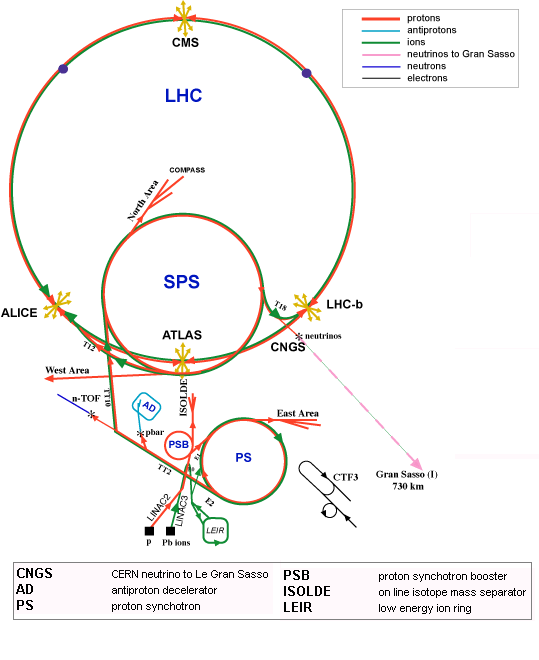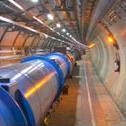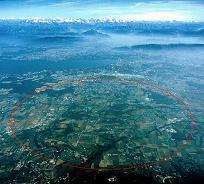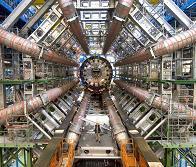The Large Hadron Collider (LHC) is situated at CERN on the French-Swiss border near Geneva. The particles are accelerated into two beams which travel in opposite directions around the 27 km circular tunnel which formerly contained the LEP accelerator. Each proton beam flying around the LHC has an energy of 7 TeV, so when two protons collide the collision energy will be 14 TeV. These collision events have the energy necessary to probe areas of Physics beyond the reach of any other experiments on Earth.
The Large Electron-Positron collider (LEP) was built in the early 1980s. From the outset groups at CERN were considering the long-term future of the CERN complex. In December 1994 CERN's Council gave approval for the construction of the LHC. Initially, the LHC was going to be a two-stage project but with the arrival of funding from non-Member states (Japan, India and the USA amongst others) construction of four major experiments ALICE, ATLAS, CMS and LHCb began in 1996. The construction of LHC was originally approved in 1995 with a budget of 2.6 billion Swiss francs. Since then, cost overruns and unforeseen engineering problems have increased costs by roughly 500 million Swiss francs to a total of £2.6 billion pound sterling.

production and decay
Our current understanding of the Universe is incomplete. Theories we currently use to describe it leave many unsolved questions; questions such as why elementary particles have mass and why their masses are different. The answer lay within the Higgs mechanism which describes how particles interact with the Higgs field to acquire mass. The Higgs Field required proof that it existed though, such as finding at least one new particle associated with it, the Higgs boson. The LHC found the Higgs boson in 2012 and enabled further research in several other areas of high energy physics.
The discovery of the Higgs boson led to the 2013 Nobel Prize being awarded jointly to François Englert and Peter W. Higgs "for the theoretical discovery of a mechanism that contributes to our understanding of the origin of mass of subatomic particles, and which recently was confirmed through the discovery of the predicted fundamental particle, by the ATLAS and CMS experiments at CERN's Large Hadron Collider".
The LHC will also help us to solve the mystery of antimatter. Matter and antimatter must have been produced in the same amounts at the time of the Big Bang. From what we have observed so far, our Universe is made of only matter. Why? The LHC could provide an answer.
It was once thought that antimatter was a perfect 'reflection' of matter - that if you replaced matter with antimatter and looked at the result in a mirror, you would not be able to tell the difference. We now know that the reflection is imperfect, and this could have led to the matter-antimatter imbalance in our Universe.
By using powerful telescopes, both on the ground and in orbit, we have found that all the visible matter (stars etc.) accounts for only 5 % of the energy thought to be present in the Universe. The search is open for particles or phenomena responsible for dark matter (which makes up 27 % of the universe), required to explain the motion of galaxies and facets of the Big Bang and dark energy (which makes up 68 % of the universe) and is required to explain the motions of very distant supernovae. Dark energy is thought to be the cause of an accelerated expansion of the universe, but it has no local gravitational effect making it incredibly difficult to detect. (For more information on dark energy and dark matter, click here).
A popular idea that could partly explain why all the matter we see in the Universe counts for only 4 % of the total mass, is called supersymmetry, or SUSY. SUSY predicts that for each known particle there is a 'supersymmetric' partner. If SUSY is right, then supersymmetric particles should be found at the LHC. However, as of yet, there has been no SUSY particle found when looking at energies up to 13 TeV.
There are five experiments installed at the LHC: A Large Ion Collider Experiment (ALICE), A Toroidal LHC ApparatuS (ATLAS), Compact Muon Solenoid (CMS), Large Hadron Collider beauty experiment (LHCb) and TOTal Elastic and diffractive cross section Measurement (TOTEM). ALICE, ATLAS, CMS and LHCb are installed in four huge underground caverns built around the four collision points of the LHC beams. TOTEM is installed near the CMS interaction point and has detectors in three different locations along the vacuum chamber of the LHC. Of these five experiments, only ATLAS and CMS are directly relevant to the search for the Higgs Boson.
ATLAS is a general-purpose detector designed to cover the widest possible range of physics at the LHC, from the search for the Higgs boson to supersymmetry (SUSY) and extra dimensions. It is 46 m long and 25 m high, the largest-volume detector ever constructed. The collaboration consists of more than 5000 members from 182 institutes in 38 countries (as of 2018, ATLAS website).
CMS is also a general purpose detector with the same physics goals as ATLAS, but different technical solutions and design. It is built around the world's largest superconducting solenoid. More than 4000 people work for CMS, from around 200 institutes in 46 countries (as of 2018, see CMS Website for more information).





